Advertisements
Chapters
2: Units and Measurements
3: Motion In a Straight Line
4: Motion In a Plane
5: Laws of Motion
6: Work, Energy and Power
7: System of Particles and Rotational Motion
8: Gravitation
▶ 9: Mechanical Properties of Solids
10: Mechanical Properties of Fluids
11: Thermal Properties of Matter
12: Thermodynamics
13: Kinetic Theory
14: Oscillations
15: Waves
![NCERT Exemplar solutions for Physics [English] Class 11 chapter 9 - Mechanical Properties of Solids NCERT Exemplar solutions for Physics [English] Class 11 chapter 9 - Mechanical Properties of Solids - Shaalaa.com](/images/physics-english-class-11_6:5f2b1b2038084cf381bfa42c826a928c.jpg)
Advertisements
Solutions for Chapter 9: Mechanical Properties of Solids
Below listed, you can find solutions for Chapter 9 of CBSE NCERT Exemplar for Physics [English] Class 11.
NCERT Exemplar solutions for Physics [English] Class 11 9 Mechanical Properties of Solids Exercises [Pages 65 - 71]
MCQ I
Modulus of rigidity of ideal liquids is ______.
infinity.
zero.
unity.
some finite small non-zero constant value.
The maximum load a wire can withstand without breaking, when its length is reduced to half of its original length, will ______.
be double.
be half.
be four times.
remain same.
The temperature of a wire is doubled. The Young’s modulus of elasticity ______.
will also double.
will become four times.
will remain same.
will decrease.
A spring is stretched by applying a load to its free end. The strain produced in the spring is ______.
volumetric.
shear.
longitudinal and shear.
longitudinal.
A rigid bar of mass M is supported symmetrically by three wires each of length l. Those at each end are of copper and the middle one is of iron. The ratio of their diameters, if each is to have the same tension, is equal to ______.
`Y_(copper)/Y_(iron)`
`sqrt((Y_(iron))/(Y_(copper)`
`Y_(iron)^2/Y_(copper)^2`
`Y_(iron)/Y_(copper)^2`
A mild steel wire of length 2L and cross-sectional area A is stretched, well within elastic limit, horizontally between two pillars (Figure). A mass m is suspended from the mid point of the wire. Strain in the wire is ______.
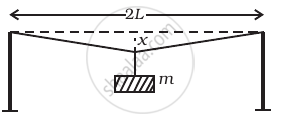
`x^2/(2L^2)`
`x/L`
`x^2/L`
`x^2/(2L)`
A rectangular frame is to be suspended symmetrically by two strings of equal length on two supports (Figure). It can be done in one of the following three ways;
| (a) | 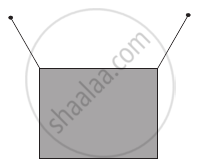 |
| (b) | 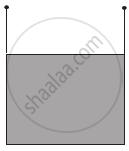 |
| (c) | 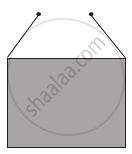 |
The tension in the strings will be ______.
the same in all cases.
least in (a).
least in (b).
least in (c).
Consider two cylindrical rods of identical dimensions, one of rubber and the other of steel. Both the rods are fixed rigidly at one end to the roof. A mass M is attached to each of the free ends at the centre of the rods.
Both the rods will elongate but there shall be no perceptible change in shape.
The steel rod will elongate and change shape but the rubber rod will only elongate.
The steel rod will elongate without any perceptible change in shape, but the rubber rod will elongate and the shape of the bottom edge will change to an ellipse.
The steel rod will elongate, without any perceptible change in shape, but the rubber rod will elongate with the shape of the bottom edge tapered to a tip at the centre.
MCQ II
The stress-strain graphs for two materials are shown in figure (assume same scale).
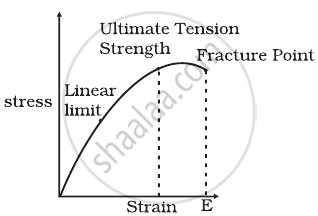 Material (i) |
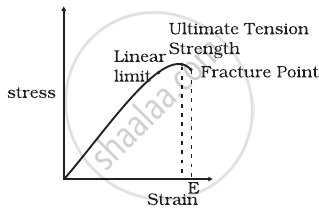 Material (i) |
- Material (ii) is more elastic than material (i) and hence material (ii) is more brittle.
- Material (i) and (ii) have the same elasticity and the same brittleness.
- Material (ii) is elastic over a larger region of strain as compared to (i).
- Material (ii) is more brittle than material (i).
A wire is suspended from the ceiling and stretched under the action of a weight F suspended from its other end. The force exerted by the ceiling on it is equal and opposite to the weight.
- Tensile stress at any cross section A of the wire is F/A.
- Tensile stress at any cross section is zero.
- Tensile stress at any cross section A of the wire is 2F/A.
- Tension at any cross section A of the wire is F.
A rod of length l and negligible mass is suspended at its two ends by two wires of steel (wire A) and aluminium (wire B) of equal lengths (Figure). The cross-sectional areas of wires A and B are 1.0 mm2 and 2.0 mm2, respectively.
(YAl = 70 × 109 Nm−2 and Ysteel = 200 × 109 Nm–2)

- Mass m should be suspended close to wire A to have equal stresses in both the wires.
- Mass m should be suspended close to B to have equal stresses in both the wires.
- Mass m should be suspended at the middle of the wires to have equal stresses in both the wires.
- Mass m should be suspended close to wire A to have equal strain in both wires.
For an ideal liquid ______.
- the bulk modulus is infinite.
- the bulk modulus is zero.
- the shear modulus is infinite.
- the shear modulus is zero.
A copper and a steel wire of the same diameter are connected end to end. A deforming force F is applied to this composite wire which causes a total elongation of 1 cm. The two wires will have ______.
- the same stress.
- different stress.
- the same strain.
- different strain.
VSA
The Young’s modulus for steel is much more than that for rubber. For the same longitudinal strain, which one will have greater tensile stress?
Is stress a vector quantity?
Identical springs of steel and copper are equally stretched. On which, more work will have to be done?
What is the Young’s modulus for a perfect rigid body ?
What is the Bulk modulus for a perfect rigid body?
SA
A wire of length L and radius r is clamped rigidly at one end. When the other end of the wire is pulled by a force f, its length increases by l. Another wire of the same material of length 2L and radius 2r, is pulled by a force 2f. Find the increase in length of this wire.
A steel rod (Y = 2.0 × 1011 Nm–2; and α = 10–50 C–1) of length 1 m and area of cross-section 1 cm2 is heated from 0°C to 200°C, without being allowed to extend or bend. What is the tension produced in the rod?
To what depth must a rubber ball be taken in deep sea so that its volume is decreased by 0.1%. (The bulk modulus of rubber is 9.8 × 108 Nm–2; and the density of sea water is 103 kg m–3.)
A truck is pulling a car out of a ditch by means of a steel cable that is 9.1 m long and has a radius of 5 mm. When the car just begins to move, the tension in the cable is 800 N. How much has the cable stretched? (Young’s modulus for steel is 2 × 1011 Nm–2.)
Two identical solid balls, one of ivory and the other of wet-clay, are dropped from the same height on the floor. Which one will rise to a greater height after striking the floor and why?
LA
Consider a long steel bar under a tensile stress due to forces F acting at the edges along the length of the bar (Figure). Consider a plane making an angle θ with the length. What are the tensile and shearing stresses on this plane

- For what angle is the tensile stress a maximum?
- For what angle is the shearing stress a maximum?
A steel wire of mass µ per unit length with a circular cross section has a radius of 0.1 cm. The wire is of length 10 m when measured lying horizontal, and hangs from a hook on the wall. A mass of 25 kg is hung from the free end of the wire. Assuming the wire to be uniform and lateral strains << longitudinal strains, find the extension in the length of the wire. The density of steel is 7860 kg m–3 (Young’s modules Y = 2 × 1011 Nm–2).
If the yield strength of steel is 2.5 × 108 Nm–2, what is the maximum weight that can be hung at the lower end of the wire?
A steel rod of length 2l, cross sectional area A and mass M is set rotating in a horizontal plane about an axis passing through the centre. If Y is the Young’s modulus for steel, find the extension in the length of the rod. (Assume the rod is uniform.)
An equilateral triangle ABC is formed by two Cu rods AB and BC and one Al rod. It is heated in such a way that temperature of each rod increases by ∆T. Find change in the angle ABC. [Coeff. of linear expansion for Cu is α1, Coeff. of linear expansion for Al is α2]
In nature, the failure of structural members usually result from large torque because of twisting or bending rather than due to tensile or compressive strains. This process of structural breakdown is called buckling and in cases of tall cylindrical structures like trees, the torque is caused by its own weight bending the structure. Thus the vertical through the centre of gravity does not fall within the base. The elastic torque caused because of this bending about the central axis of the tree is given by `(Ypir^4)/(4R) . Y` is the Young’s modulus, r is the radius of the trunk and R is the radius of curvature of the bent surface along the height of the tree containing the centre of gravity (the neutral surface). Estimate the critical height of a tree for a given radius of the trunk.
A stone of mass m is tied to an elastic string of negligble mass and spring constant k. The unstretched length of the string is L and has negligible mass. The other end of the string is fixed to a nail at a point P. Initially the stone is at the same level as the point P. The stone is dropped vertically from point P.
- Find the distance y from the top when the mass comes to rest for an instant, for the first time.
- What is the maximum velocity attained by the stone in this drop?
- What shall be the nature of the motion after the stone has reached its lowest point?
Solutions for 9: Mechanical Properties of Solids
![NCERT Exemplar solutions for Physics [English] Class 11 chapter 9 - Mechanical Properties of Solids NCERT Exemplar solutions for Physics [English] Class 11 chapter 9 - Mechanical Properties of Solids - Shaalaa.com](/images/physics-english-class-11_6:5f2b1b2038084cf381bfa42c826a928c.jpg)
NCERT Exemplar solutions for Physics [English] Class 11 chapter 9 - Mechanical Properties of Solids
Shaalaa.com has the CBSE Mathematics Physics [English] Class 11 CBSE solutions in a manner that help students grasp basic concepts better and faster. The detailed, step-by-step solutions will help you understand the concepts better and clarify any confusion. NCERT Exemplar solutions for Mathematics Physics [English] Class 11 CBSE 9 (Mechanical Properties of Solids) include all questions with answers and detailed explanations. This will clear students' doubts about questions and improve their application skills while preparing for board exams.
Further, we at Shaalaa.com provide such solutions so students can prepare for written exams. NCERT Exemplar textbook solutions can be a core help for self-study and provide excellent self-help guidance for students.
Concepts covered in Physics [English] Class 11 chapter 9 Mechanical Properties of Solids are Stress-strain Curve, Stress and Strain, Hooke’s Law, Young’s Modulus, Shear Modulus or Modulus of Rigidity, Bulk Modulus, Application of Elastic Behaviour of Materials, Elastic Energy, Elastic Behaviour of Solid, Poisson’s Ratio, Determination of Young’s Modulus of the Material of a Wire.
Using NCERT Exemplar Physics [English] Class 11 solutions Mechanical Properties of Solids exercise by students is an easy way to prepare for the exams, as they involve solutions arranged chapter-wise and also page-wise. The questions involved in NCERT Exemplar Solutions are essential questions that can be asked in the final exam. Maximum CBSE Physics [English] Class 11 students prefer NCERT Exemplar Textbook Solutions to score more in exams.
Get the free view of Chapter 9, Mechanical Properties of Solids Physics [English] Class 11 additional questions for Mathematics Physics [English] Class 11 CBSE, and you can use Shaalaa.com to keep it handy for your exam preparation.
